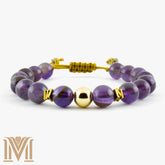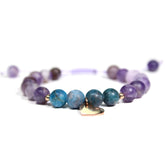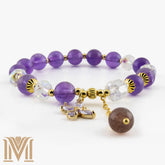Amethyst: The Timeless Stone of Mystery and Beauty
Amethyst is a captivating purple gemstone cherished for its beauty and the myriad of beliefs surrounding its properties. Let's delve into its history, purported healing attributes, common uses, and tips on distinguishing genuine amethyst from imitations.

Historical Significance of Amethyst
Ancient Civilizations
The allure of amethyst dates back to ancient times. Archaeological findings have unearthed amethyst jewelry as old as 3,000 BCE in Egypt, indicating its prominence among pharaohs who believed the stone offered protection against harm and evil.
In ancient Greece, amethyst was linked to Dionysus, the god of wine and pleasure. The Greeks believed that wearing amethyst could prevent intoxication, leading to its name derived from the Greek word "amethystos," meaning "not drunk."
Middle Ages and Renaissance
During the Middle Ages, amethyst was considered a symbol of royalty and used to adorn English regalia. It was also believed to possess calming properties, aiding in meditation and enhancing intellectual thought.
Biblical References
Amethyst holds significance in religious texts as well. In the Bible, it is mentioned as one of the twelve stones adorning the breastplate of the high priest Aaron, symbolizing the tribe of Dan. Additionally, amethyst is listed as the twelfth foundation stone of the New Jerusalem in the Book of Revelation, highlighting its esteemed status in Judeo-Christian traditions.
Believed Healing Properties
Amethyst has long been associated with various healing properties, both mental and physical:
Mental and Emotional Well-being
- Stress Relief: Often referred to as a natural tranquilizer, amethyst is believed to alleviate stress and soothe irritability, promoting a sense of calm.
- Emotional Balance: It is thought to balance mood swings, dispel anger, rage, fear, and anxiety, and alleviate sadness and grief.
Spiritual Awareness
- Intuition Enhancement: Amethyst is said to activate spiritual awareness, open intuition, and enhance psychic abilities..
- Sobriety Aid: Historically, it was believed to encourage sobriety, having a sobering effect on overindulgence in alcohol, drugs, or other addictions.
Physical Health
- Sleep Support: Some believe that amethyst can relieve insomnia and assist in remembering and understanding dreams.
Please note: These healing properties are based on beliefs and traditions. There's limited scientific evidence to support these claims.
Chakra Associations
In metaphysical practices, amethyst is closely linked to the Third Eye and Crown Chakras:
- Third Eye Chakra: Located between the eyebrows, this chakra is associated with intuition, insight, and spiritual awareness. Amethyst's energy is believed to enhance these qualities, aiding in the development of psychic abilities and inner wisdom.
- Crown Chakra: Situated at the top of the head, the crown chakra represents the connection to the divine and higher consciousness. Amethyst is thought to facilitate this connection, promoting spiritual growth and enlightenment.
Birthstone Associations
Amethyst is traditionally associated with the month of February. As the birthstone for this month, it symbolizes qualities such as wisdom, spirituality, and sincerity. Those born in February often wear amethyst to bring clarity of mind and enhance their intuition.
In addition to its monthly association, amethyst is linked to certain zodiac signs:
- Aquarius (January 20 - February 18): Amethyst is believed to support Aquarians by enhancing their natural creativity and providing balance to their often forward-thinking minds.
- Pisces (February 19 - March 20): For Pisceans, amethyst is thought to promote emotional balance and protect against negative energies, aligning with their sensitive and empathetic nature.
Common Uses
- Jewelry: Amethyst's vibrant color makes it popular in rings, necklaces, and bracelets. It's also the birthstone for February, symbolizing wisdom and calmness.
- Home Décor: Beyond jewelry, amethyst geodes and clusters are used as decorative pieces in homes and offices, adding a touch of natural beauty.
- Meditation: Some people use amethyst during meditation, believing it helps calm the mind and enhance spiritual growth.

Distinguishing Authentic Amethyst from Imitations
With the popularity of amethyst, imitations have become common. Here are some tips to identify genuine amethyst:
- Color Zoning: Natural amethyst typically exhibits color zoning, with varying shades of purple and white. Uniformly colored stones might be synthetic or dyed.
- Hardness Test: Amethyst ranks 7 on the Mohs hardness scale. It should resist scratches from materials like steel. Gently scratching an inconspicuous area with a steel knife shouldn't leave a mark.
- Temperature Check: Real gemstones often feel cool to the touch and take time to warm up, whereas glass imitations may match room temperature quickly.
- Bubble Inclusions: Using a magnifying glass, inspect the stone for bubbles. Bubbles can indicate glass imitations.
- Professional Evaluation: When in doubt, consult a certified gemologist for an expert opinion.
Caring for Amethyst
To maintain the beauty of your amethyst:
- Cleaning: Use mild soap and lukewarm water. Avoid harsh chemicals.
- Storage: Store separately from harder gemstones to prevent scratches.
- Sunlight: Prolonged exposure to direct sunlight can fade its color.
Amethyst's rich history and captivating color make it a cherished gemstone in various cultures. Whether you're drawn to its beauty or the meanings associated with it, amethyst remains a timeless choice.












